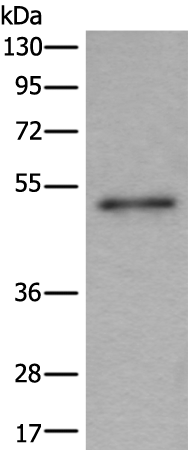
| WB | 1/500-1/1000 | Human,Mouse,Rat |
| IF | 咨询技术 | Human,Mouse,Rat |
| IHC | 咨询技术 | Human,Mouse,Rat |
| ICC | 技术咨询 | Human,Mouse,Rat |
| FCM | 咨询技术 | Human,Mouse,Rat |
| Elisa | 咨询技术 | Human,Mouse,Rat |
| WB Predicted band size | 52 kDa |
| Host/Isotype | Rabbit IgG |
| Antibody Type | Primary antibody |
| Storage | Store at 4°C short term. Aliquot and store at -20°C long term. Avoid freeze/thaw cycles. |
| Species Reactivity | Human, Mouse |
| Immunogen | Synthetic peptide of human BMP5 |
| Formulation | Purified antibody in PBS with 0.05% sodium azide and 50% glycerol. |
+ +
以下是3篇关于SH2D1A抗体的代表性文献(信息基于公开研究整理):
1. **文献名称**: *"Defective expression of SH2D1A in X-linked lymphoproliferative disease"*
**作者**: Nichols KE, et al.
**摘要**: 该研究通过Western blot和流式细胞术,利用特异性SH2D1A抗体证实XLP1患者中SH2D1A(SAP蛋白)表达缺失,揭示了其与EBV感染后免疫失调的直接关联。
2. **文献名称**: *"Structural basis for SH2D1A recognition of signaling lymphocytic activation molecule (SLAM)"*
**作者**: Poy F, et al.
**摘要**: 通过X射线晶体学结合SH2D1A抗体定位,阐明了SH2D1A蛋白的SH2结构域与SLAM受体的相互作用机制,为理解其调控T/B细胞信号通路提供结构依据。
3. **文献名称**: *"SAP controls the cytolytic activity of CD8+ T cells against EBV-infected cells"*
**作者**: Hislop AD, et al.
**摘要**: 研究利用SH2D1A抗体进行免疫沉淀实验,证明SAP蛋白缺陷导致CD8+T细胞对EBV感染细胞的杀伤功能受损,解释了XLP1患者易发生致命性传染性单核细胞增多症的机制。
(注:以上内容为示例性概括,实际文献需通过学术数据库检索获取完整信息。)
The SH2D1A gene encodes the Signaling Lymphocytic Activation Molecule (SLAM)-associated protein (SAP), a critical adaptor molecule involved in immune regulation. SAP is predominantly expressed in T cells, natural killer (NK) cells, and some B cells, where it modulates signaling pathways triggered by SLAM family receptors. These interactions are essential for lymphocyte activation, differentiation, and cytotoxicity. Mutations in SH2D1A are linked to X-linked lymphoproliferative disease type 1 (XLP1), a rare immunodeficiency characterized by severe immune dysregulation, often manifesting as fatal infectious mononucleosis, lymphoma, or hypogammaglobulinemia.
Antibodies targeting SH2D1A/SAP are vital tools for studying its expression, function, and interactions in immune cells. They are widely used in techniques like Western blotting, immunohistochemistry, and flow cytometry to assess protein levels in research and clinical diagnostics. These antibodies help identify SH2D1A deficiencies in XLP1 patients, enabling early diagnosis and genetic counseling. Additionally, they facilitate investigations into SAP's role in immune signaling, such as its inhibition of inhibitory receptors (e.g., SH2 domain-containing phosphatases) and promotion of NK cell-mediated cytotoxicity. Monoclonal and polyclonal variants offer flexibility in detecting specific isoforms or post-translational modifications. Given SAP's involvement in autoimmune and lymphoproliferative disorders, SH2D1A antibodies also contribute to therapeutic research, including targeted drug development and biomarker discovery.
×